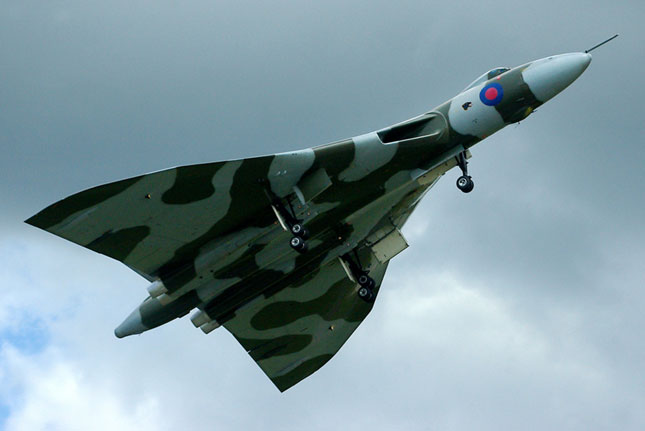Motorsport
& AD Group News
2008
Vulcan to the Sky over Silverstone. Issued September 17th
2008
Vulcan
to the Sky over Silverstone
There
was a moment during last weekend’s Le Mans Series
epic, at just before four on Sunday afternoon, when all
eyes were drawn away from the action on the track for a
few minutes. It takes something pretty special to achieve
that, especially when you’ve got what was probably
one of the best endurance races seen in Britain for years
unfolding before you. No matter how titanic the battle between
Audi and Peugeot, there’s something unmissably majestic
and wonderful about the sight of an Avro Vulcan trailing
wisps of grey smoke across a clear blue sky.
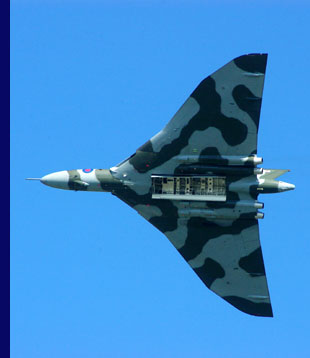 XH558
was on her way back from Leuchars in Fife, Scotland, and
bound for her current (temporary) base at Brize Norton in
Oxfordshire. The sole surviving airworthy Vulcan had been
scheduled to display at the RAF Leuchars Air Show the previous
afternoon, but bad weather had prevented her taking off.
XH558
was on her way back from Leuchars in Fife, Scotland, and
bound for her current (temporary) base at Brize Norton in
Oxfordshire. The sole surviving airworthy Vulcan had been
scheduled to display at the RAF Leuchars Air Show the previous
afternoon, but bad weather had prevented her taking off.
Luckily
for those at Silverstone, Sunday’s skies were clear,
and she was able to complete her return flight and pass
over the circuit. Despite the petulant wail of forty sports
and GT cars tearing around in circles, the throaty roar
of her four Olympus 202 jet engines could still be heard
as she swept overhead. It’s one of those wonderful
sounds that needs to be felt, deep down in the pit of one’s
stomach, to be truly appreciated.
Well,
if that sort of experience is for you, and you missed her
chance flypast on Sunday, don’t despair. She is due
to make a repeat appearance this weekend, not only at Silverstone
to mark the start of the Britcar 24 Hours, but also above
Goodwood on Sunday. The timings are a little vague at present,
but we’ve been advised that XH558 should shake the
Silverstone grandstands at some time between four and four-thirty
on Saturday afternoon, and similarly, mid-afternoon at Goodwood
the following day.
The
link between a fast, noisy and enormously impressive aircraft,
like the Vulcan, and the fast, noisy and exciting racecars
of Silverstone and Goodwood, is more than just a “boys
toys” thing. Actually, far from it, because it’s
more tangible than that, and there really is a surprisingly
close relationship between XH558 and motorsport, but more
on that later. First, a bit of background . . .
What
is it about an Avro Vulcan that can bring tears to the eyes
of grown men – and women for that matter? It’s
easy enough to understand when one sees, for example, a
fly-past by the Battle of Britain Memorial Flight.
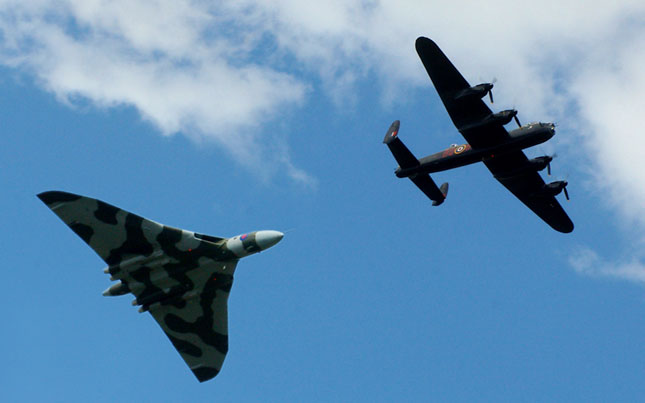
The
distinctive drone of the Rolls Royce Merlin engine, whether
it’s powering a Spitfire or a Lancaster, is a unique
and very emotive one, and the glimpse of those aircraft,
still gracing the skies after sixty years never fails to
send a shiver down one’s spine. It conjures up mental
images of young men in leather jackets, the thud of ack-ack,
boundless bravery, and crackly speeches over the Home Service
wireless. It’s heady stuff - Britain’s “Finest
Hour” and all that - so how can a plane that only
retired from active service twenty years ago achieve much
the same effect? Pride, certainly, but there’s also
a fair amount of that “Shock and Awe” that we
heard so much about from the US Air Force a few years ago.
The Vulcan is, truly, an awesome bit of kit.
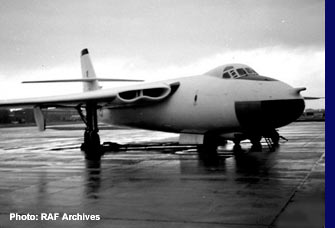 Arising
from the dark and sinister era of the Cold War, the Vulcan
was one of three so-called V-Bombers, designed and created
in the years immediately after the Second World War to carry
and deliver Britain’s nuclear bomb to the Soviet Union.
Arising
from the dark and sinister era of the Cold War, the Vulcan
was one of three so-called V-Bombers, designed and created
in the years immediately after the Second World War to carry
and deliver Britain’s nuclear bomb to the Soviet Union.
The
first of these, the Vickers Valiant (left), made
its debut in 1951, while the Avro Vulcan and Handley Page
Victor (below) followed a year later. For twenty
years this Strategic Nuclear Strike Force formed the backbone
of Britain’s nuclear deterrent. At its peak in the
mid-Sixties there were 50 Valiants, 39 Victors and 70 Vulcans
patrolling the skies, and perhaps the fact that never once
did they fulfil their role in anger suggests that they performed
their duties perfectly.
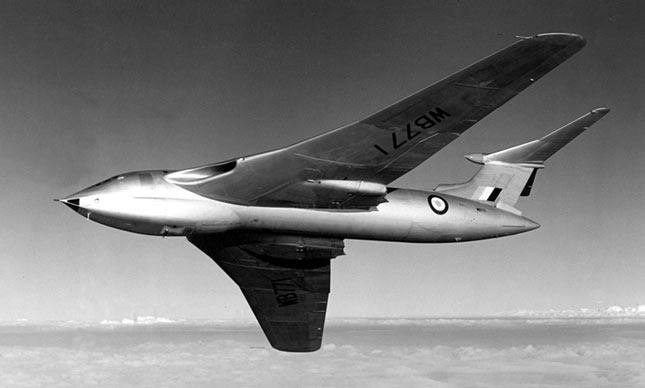
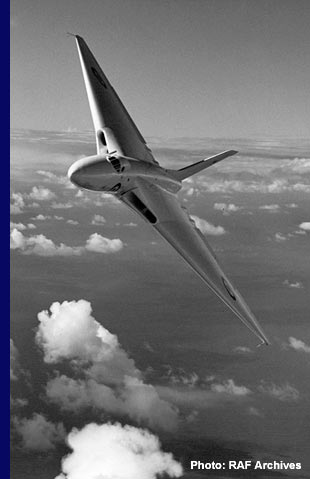 When
the time came for the V-Bombers to be withdrawn from service,
they did so in the same order they’d appeared. The
Valiant, which was a more conventional aircraft in design
and construction, was the first to end its active days.
The plane suffered from premature metal fatigue at the base
of its broad wings, and was withdrawn in 1965. The Victor
– perhaps the most shapely of the three – was
converted to an airborne refuelling role, and continued
in service until the first Gulf War in 1991. The Vulcan
(right) was also converted to tanker duties during
the 1980’s, but retired from the RAF front-line in
1984.
When
the time came for the V-Bombers to be withdrawn from service,
they did so in the same order they’d appeared. The
Valiant, which was a more conventional aircraft in design
and construction, was the first to end its active days.
The plane suffered from premature metal fatigue at the base
of its broad wings, and was withdrawn in 1965. The Victor
– perhaps the most shapely of the three – was
converted to an airborne refuelling role, and continued
in service until the first Gulf War in 1991. The Vulcan
(right) was also converted to tanker duties during
the 1980’s, but retired from the RAF front-line in
1984.
Prior
to this, and having been stood down from their nuclear role
following the introduction of the ICBM, the Vulcans were
converted to carry conventional armaments, and could deliver
a payload of twenty-one 1,000 lb bombs.
Famously,
of course, it was the Vulcan that carried out what remains
to this day the most logistically demanding and remote bombing
mission ever attempted - Operation Black Buck.
This required Vulcans of the Royal Air Force, temporarily
based at Ascension Island in the mid-Atlantic, to carry
out five bombing raids on Argentine positions at Port Stanley
airfield in the Falkland Islands in 1982 – a round
trip of some 8,000 miles. (The record was technically broken
when USAF B52s based in the UK bombed positions in Iraq
in 1991, although these aircraft benefited from in-flight
refuelling supplied by remote aircraft en-route, not by
others flying alongside.)
Two
years after this, having been converted to in-flight refuelling
tankers, the final Vulcans were retired from active service.
One, however, XH558, was retained by the RAF, and for the
next eight years she wowed the crowds at air displays all
around the country. Stripped out and lovingly maintained,
she was lighter and fitter than ever before. I recall seeing
her at the last-ever Upper Heyford air display in 1992,
where slack-jawed F-111 pilots stood in amazement as this
massive aircraft performed turns and rolls with the agility
of a fighter. Aptly named, the sheer gut-wrenching howl
of the Vulcan at take-off, when those four Olympus 202s
were at maximum thrust, was like something erupting from
the furnaces of Hell.
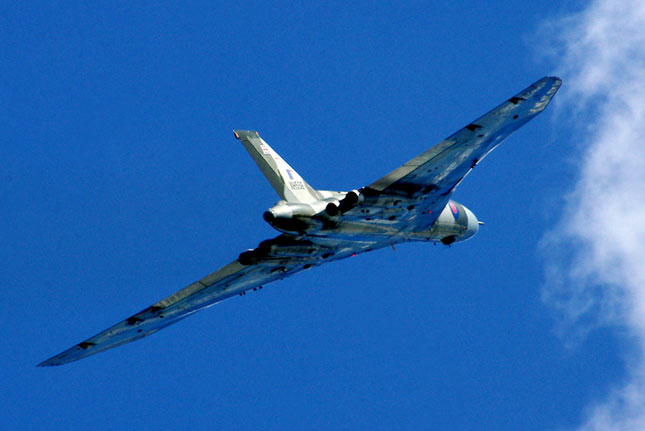
Sadly,
at the end of that year, the RAF declared that the cost
of keeping her airborne was too great a burden, and she
was packed off to Bruntingthorpe in Leicestershire and hobbled.
Yes, she could taxi up and down the runway, but never again
would she grace the skies. That was until the Vulcan
to the Sky Trust was formed. Over the last three years
the Trust has battled to get the last surviving Vulcan back
into the air, and they finally achieved their objective
on 18th October 2007, when XH558 completed a 34-minute test
flight. The restoration had cost more than £6 million,
much of it by private donation, as well as countless hours
of hard work by volunteers and enthusiasts. Just over £2½
million came from lottery funding, as well as individual
donations varying between a few pence and £500,000.
It was a monumental achievement, but the fight wasn’t
over yet.
Just
getting XH558 air-worthy again was only one battle in a
lengthy campaign. One of the largest and most complex aviation
restoration projects ever attempted had ticked so many boxes,
but it still needed to acquire that official signature at
the bottom of the form that would not only permit the plane
to fly, but to perform at public displays. That was when
the motorsport connection kicked in . . .
 Ann
Newton, wife of RML racing driver Mike Newton, has always
been a plane enthusiast, and had seen the Vulcan at various
air shows during the early 1990s. Then, soon after XH558
made that inaugural flight in October last year, she became
aware of the new challenge facing the Trust.
Ann
Newton, wife of RML racing driver Mike Newton, has always
been a plane enthusiast, and had seen the Vulcan at various
air shows during the early 1990s. Then, soon after XH558
made that inaugural flight in October last year, she became
aware of the new challenge facing the Trust.
Fortunately,
her husband is a qualified pilot and shares her love of
aircraft. “The interest was mine initially,”
she admits. “My father was in the RAF, and I’ve
always loved planes as much as cars. I’d been following
the programme for a while, but when I learned of the Trust’s
difficulties, I persuaded Mike that we should get involved.
We wanted to help get the funding back on stream. The Trust
had already put so much into the project, and just needed
a bit more to complete the roll-out.”
“After
that first flight, the Trust faced a serious shortage of
money,” explains Mike. “We offered to fund the
test flight programme, and although these flights weren’t
seen by many people, they allowed the Vulcan to achieve
her vital display certification. Once she was over that
financial hump, she was then able to take part in a series
of major air displays and events during the course of the
summer.”

The
couple’s association is on-going however, and after
the initial input, Ann and Mike have now persuaded AD Group
to take a professional interest. Using their hi-tech video
imaging expertise, and AD Aerospace products such as FlightVu
that will be familiar to anyone who’s seen the RML
MG Lola in action, AD Group is now involved in the introduction
of video monitoring systems aboard the Vulcan. “We
hope to have cameras fitted in the cockpit, in the bomb
bay, and also to give views of the aircraft in flight,”
explains Ann. “This was very much an afterthought,
and we couldn’t introduce the cameras until the plane
had received all its air-worthiness certificates, but with
that now complete, AD Aerospace can get involved.”
Part
of the requirements behind the Vulcan’s receipt of
lottery funding was that she should become the centrepiece
to an educational programme highlighting Britain’s
role in the Cold War, and having the cameras aboard XH558
will give schoolchildren a much better idea of what it is
like to “fly” in one of these awesome aircraft.
“Taking the programme forwards into schools is the
next stage,” says Ann. “There is also the question
of finding a permanent base for her.” XH558 was at
RAF Waddington in Lincolnshire for six weeks from June,
and then moved to Brize Norton for servicing and repairs
in August. She’s been there ever since.
“The
guys behind the Vulcan to the Sky Trust are all
such wonderful people,” adds Ann. “They’ve
made this aircraft such a huge part of their lives, and
they’re so dedicated. It’s a very long-term
project, and Mike and I are just delighted to have been
able to help in some way.” Mike agrees. “It’s
an amazing achievement by everyone concerned. Unfortunately,
the Vulcan has a very finite life ahead of her, and in eight
to ten years time she’ll have to be grounded permanently.
We hope that having the cameras aboard and recording her
every flight, we’ll be able to create something for
posterity, and yet enjoy her to the full while she’s
still in the skies above us.”
The
Trust intends to keep XH558 flying for as long as possible,
but the mechanical life of many of her components, including
the airframe, means that she cannot be kept flying for ever.
Her schedule is to complete about fifty flying hours per
year at a cost of roughly £135,000 per month, and
at a gross annual cost of just over £1½ million.

However,
all this hope and aspiration may be for nothing. The current
economic climate is not conducive to finding commercial
sponsorship, and Robert Pleming, Chief Executive, Vulcan
to the Sky Trust, gave this blunt appraisal a few days
ago: “Despite the success of the Vulcan at airshows
this summer, sadly I have to let you know that, by a significant
margin, insufficient sponsorship funding has been found
to secure the aircraft’s future. We understand that
the reticence of potential sponsors may be based on three
ill-founded concerns: perception of risk of accident (effectively
negligible), a carbon footprint (we will be carbon neutral),
and military connotations (something of which we all should
be proud).”
“Our
appeal to supporters for monthly donations has continued
to provide a source of some optimism, with the total now
amounting to over £10,000 per month. This regular
monthly income is really important, because if it continues
to grow, it could provide the basis for a happier future
for XH558 in today’s difficult economic conditions.
If you haven’t already, please consider a monthly
standing order – even £2 per month with Gift
Aid amounts to £30 per year.”
“XH558’s
flying career could also still be saved if a few high-profile
people came forward with offers of help. However, to be
realistic, it looks as if the door may now be closing on
the future of the Vulcan in flight. I think that anyone
wishing to see a Vulcan in flight should do so as soon as
possible. With the public’s help, the triumphant return
of the Vulcan this summer became the not-to-be-missed spectacle
of the season and I sincerely hope that 2008 will not also
turn out to be her swansong.”
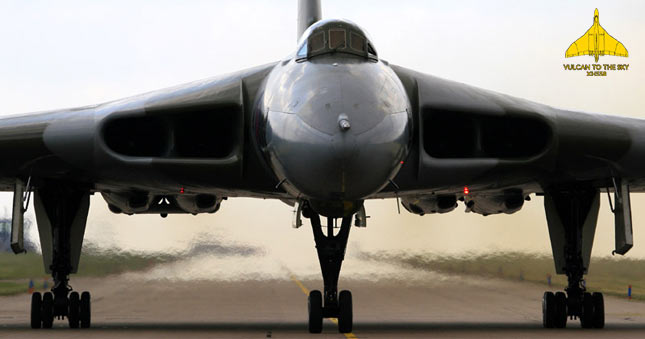
So,
as you shield your skyward gaze with one hand this weekend,
and marvel as the Vulcan passes overhead, dig deep into
your pockets with the other, and promise yourself that,
when you get home (or now, if you prefer), you’ll
visit the website and offer whatever support you can. Click
on the banner below to visit the website.

With
thanks to the Vulcan to the Sky Trust for the two
photos above, bearing their distinctive logo. The black
and white photos are courtesy RAF Archives. All other photos
were taken by Marcus / CMC Graphics at the Waddington Air
Show in July 2008. Any reproduction elsewhere must include
an acknowledgement.
